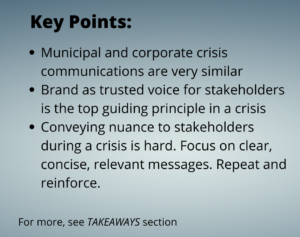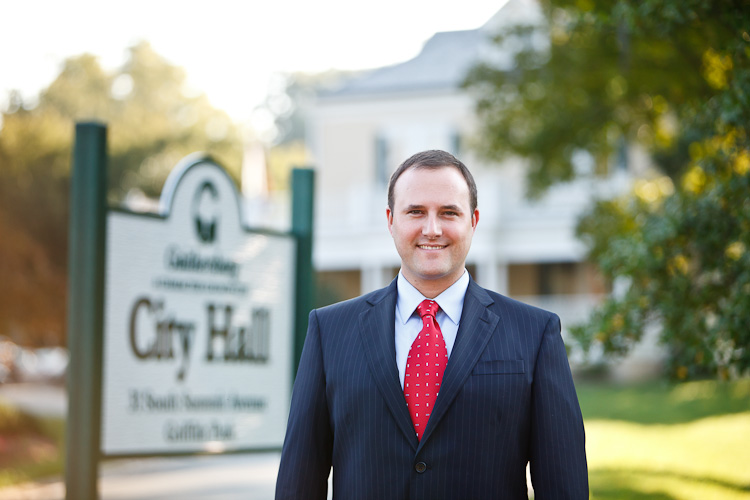(Photo by Rachael Spiegel)
Pop quiz. It’s the COVID-19 pandemic. You’re a councilperson or a mayor of a small U.S. city or town. Federal, state and local agencies are issuing a storm of new policies and information. Your constituents want answers about safety and their livelihoods. What do you do?
Ryan Spiegel has been there. He is both president of the Maryland Municipal League (MML) of 157 towns and cities, and a councilman for the City of Gaithersburg—one of Maryland’s largest cities. He is also a partner at Bethesda, Maryland-based law firm Paley Rothman.
At three months into the pandemic, I reached out to Spiegel to find out more about communication’s role in municipalities meeting the challenges of COVID-19, and how the same principles could apply to corporate communications.
 Liam Davitt: After Maryland’s COVID-19 pandemic lockdown started in March, what were you and other municipal leaders up against and what were you trying to do?
Liam Davitt: After Maryland’s COVID-19 pandemic lockdown started in March, what were you and other municipal leaders up against and what were you trying to do?
Ryan Spiegel: When we started dealing with the pandemic in March and April, there were a lot of unknowns about safety, the economy and policy.
As municipal leaders—councilmembers, mayors, and other local officials—we’re necessarily acting as conduits and interpreters of COVID-19 information, and that information is changing constantly. The public looks to us as trusted sources for guidance and answers, but most of us aren’t experts in public health or virology. We’re on frequent conference calls with state and county agencies to get the latest numbers, decisions and other information.
Our constituents need us to process what all that means and relay it as digestible, relevant information aligned with our policies, values, and brand. How do stay-at-home orders apply to my daycare? How do the timing and rules for reopening affect my business? We also have to reach out among municipal, county and state governments to work through practical and regulatory questions like emergency plans and sunshine laws, as well as jurisdictional questions about which level of government has authority over which issues.
At the MML, our job is to help leaders of municipalities, particularly smaller towns with fewer resources, do all that. They’re often volunteers, and they don’t have much staff. We have to create opportunities to connect them to information and resources at the state level. Imagine being mayor of a small town by the Chesapeake Bay where restaurants are the core of your economy. You’re going to need answers about when outdoor dining can come back, how the rules apply, and what types of aid are available for shuttered businesses and laid off workers.
That said, municipal leaders have one big advantage as communicators. We are the level of government closest to the people—our audience. We know the community because we’re an integral part of it. Our constituents are our neighbors. We walk the same streets and shop in the same stores. We have a deep connection to the day-to-day, minute-to-minute pulse of life in our towns and cities.
LD: What was it like handling and communicating about the pandemic? What successes did you have?
RS: It was nerve-racking. There was so much we didn’t know, and I don’t like to call audibles, especially when lives and livelihoods are on the line. I prefer being thoughtful and deliberative, but in a pandemic we don’t have that luxury. Constituents and municipal leaders are relying on us for timely answers.
In Gaithersburg, we have been actively pushing out information to constituents about recommended safety measures, COVID-19 testing, free meal sites, state and local COVID-19 statistics, ways to safely volunteer to help, and our comprehensive plans for phased reopening of city facilities. We made heavy use of social media in our external communications to put out clear updates about closures, volunteer opportunities, and more—relying on concise infographics and charts.
Through the MML, we pivoted just as quickly, transmitting updates weekly if not more often to our local leaders throughout the state. Internal communications were essential, both to coordinate at the municipal level and to filter input from municipalities up to the county and state level.
We built a bank of sample emergency management and response plans to share with municipalities, and we tracked the degree to which state and county agencies were sharing federal relief funding with our cities and towns. One of our biggest successes was transforming MML’s large large annual summer conference in Ocean City—an event beloved for its rich educational content and networking opportunities—into an engaging virtual experience, in a very tight timeframe and with no playbook to go by. As it turned out, the theme that I chose for MML this year as its president, “Reimagine Tomorrow,” has been the perfect call to action in this time of unprecedented challenges. Our “reimagined” conference now has several hundred registrants.
LD: Communicators in business face COVID-19 and other crises; what parallels can you draw that might help them? What communications techniques and channels have been most effective?
RS: When communicating out to constituents about the pandemic, maintaining our brand as a trusted voice was our top guiding principle. I think that’s true of any organization in a pandemic speaking to its stakeholders. The focus has to be on crafting honest, current, reassuring messages. Don’t overpromise, but do empathize.
In a crisis, when people are hungry for information, the marketplace of content quickly gets swamped by all sorts of messengers, including many who are unscrupulous. The best way to preserve your brand as a trusted voice in this midst of that is to live the values of that mantra every day, by working hard to earn trust through a proven track record of honesty and relevance. Gaithersburg’s brand was not built overnight; it took time. And when the pandemic hit, we didn’t throw our values out the window in favor of quick hits or increased volume of social media views. While government has different rules and missions than the private sector, I think these lessons apply equally to brand reputation for business. And it is worth mentioning that we have worked closely with many nonprofits and businesses throughout this pandemic, and they are truly our partners.
The tough part is that while the message has to stand out, it also has to convey nuance. In the speed and anxiety of a crisis, audiences aren’t as sensitive to nuance. For instance, when governments first announce a gradual reopening, there must be clear, succinct and strong communication of the parameters, with regular reinforcement. Otherwise, there are serious risks if people just hear the word “reopening” and begin to flout safety protocols, misinterpreting the message to mean that all restrictions are lifted. In our region, a Phase 1 reopening still meant that many businesses and facilities remained closed or strictly limited. Nuance has always been a challenge in communications, particularly for governments, but it is critical here.
While I can’t say what worked for each mayor or council across Maryland, I can speak to my own. A holistic approach of coordinated messaging across multiple platforms—social media, e-newsletters, website postings, press releases for earned media with local news outlets, announcements at televised council meetings, YouTube clips, and more—magnified through recirculation by individual councilmembers, officials and friends of the city, helped our content echo through the community. Depending on your audience, multilingual messaging may also be key. Gaithersburg boasts one of the most diverse populations of any city in America.
Ironically, with more people stuck at home using videoconferencing platforms for work, school or family, there is an opportunity for more engagement with the public through virtual city council meetings. Residents who may have otherwise been too busy to attend a town council meeting in person before the pandemic can now dial in to a Zoom session and perhaps even testify remotely at a public hearing. They may have more time at the moment to follow local government activities. It will be fascinating to see how these developments may permanently change local government’s approach to connecting with constituents even after the pandemic is over.
Takeaways for Corporate Communications
The communications principles for municipalities and for businesses in crises like pandemic are very much the same. However, Spiegel offers valuable context and depth on those basics. Here are four top takeaways:
ONE: Brand as Trusted voice in a crisis for stakeholders
- Trust comes from a proven track record of consistent honesty and relevance
- Do empathize with audiences, reassuring them, but don’t overpromise
- In a crisis, the marketplace of content gets swamped by many messengers, including some who are unscrupulous; brand as trusted voice is the antidote
TWO: Communicate Frequently, Simply and Quickly
- Emphasize clarity; audiences aren’t as sensitive to nuance during a crisis
- Regular reinforcement of unchanged messages in a changing situation
- Don’t forget infographics; with the right channel and timing, they can be better than text
THREE: Know Your Audience and Meet Them Where They Are
- Earned media has the largest reach — don’t forget press releases and even social media like Twitter as a pitching medium
- Social media channels for external communications work for large, diffuse groups of public stakeholders; don’t forget to solicit influencer allies to amplify
FOUR: Planning, Teaming and Clear Lines of Communication and Decisionmaking are Key
- Assign roles for clear decisionmaking
- Collaborate—no one can do it on their own, especially in a crisis
- Make time to plan; share and borrow plans with allies and peers
What have you learned as a corporate communicator in the COVID-19 pandemic? Please share your thoughts!
For further reading on COVID-19 and Corporate Communications, check out:
- Corporate communications and telework — “Face to Face at a Distance: Make it Work”
- Tone and avoiding missteps in COVID-19 communications — “Read the Room: Be the Caribou, Not the Chicken”
- Reopening communications — “Communicating Your Reopening: Allaying Fears and Mitigating Risks”
- Going virtual for conferences — “With Conference Season Looming, Prepare to Pivot”
- Focus on corporate social responsibility for COVID-19 — “COVID-19 Communications: Community Before Business”


